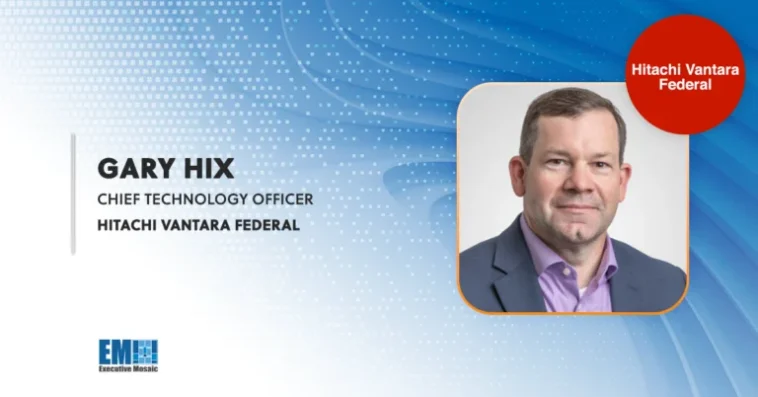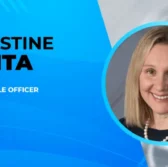Over the last three decades, Gary Hix has watched government contracting evolve dramatically, while still retaining its core principles. He’s no passive observer though: he’s played an active role at companies like Sallie Mae, Novus Consulting Group and IBM. His interest in computer work traces back to high school, but he didn’t develop a predilection for programming until a little later, going on to do work with mainframes, then Unix administration and, eventually, data storage.
For the last decade, Hix has been a key player at the federal arm of Hitachi Vantara (formerly Hitachi Data Systems), the Santa Clara-based information technology organization. He first came on as a sales engineer, nurturing his love for client relationships and guiding customers through an entire process — from identifying their needs to designing and implementing solutions, ensuring they meet their objectives. In July 2020, he ascended to the chief technology officer role, leading all technology efforts for the company’s U.S. government business.
ExecutiveBiz had the chance to talk to Hix and get his perspective on the current state of federal cloud migration, cybersecurity, artificial intelligence and more.
What are some of the key barriers that remain in widespread federal cloud migration, and how do you think we can overcome them?
I believe the biggest challenge lies in the misconception that everything can seamlessly transition to the cloud. Many assume that all operations can simply migrate to a cloud environment, but in reality, most organizations will end up in a hybrid cloud state. Even government agencies, despite their efforts to move entirely to the cloud, have found that not all workloads are suitable for cloud hosting. Some agencies are even bringing back certain cloud workloads to on-premises environments due to various reasons.
While cloud-native applications can enhance mission capabilities, many agencies have simply ‘lifted and shifted’ their operations to the cloud without considering the costs and benefits adequately. This approach often results in inflated expenses and underutilization of cloud features such as elasticity. Therefore, it’s crucial for organizations to adopt a “cloud-smart” approach, making informed decisions about where each application should reside. Additionally, leveraging technologies that support hybrid cloud environments can facilitate this transition. Hitachi, for instance, is focusing on developing strategies specifically tailored for hybrid cloud adoption, recognizing it as the direction most organizations are heading. Recent announcements such as VSP One highlight this direction.
What opportunities can be unlocked with the cloud, and how do you think those opportunities will change the federal landscape?
Indeed, there are numerous opportunities arising from the evolution of IT operations. Personally, I see the cloud not merely as a destination but rather as an operating model, often characterized by a different financial structure. Essentially, it shifts the responsibility of running infrastructure from in-house data centers to external providers. This transition allows organizations, especially governmental agencies, to focus more on their core missions without the burden of managing physical data centers.
However, this shift also introduces complexities, particularly in areas such as data governance and security. Cloud environments necessitate meticulous attention to ensure that data remains secure and accessible only to authorized individuals for appropriate purposes. This heightened focus on security is a significant challenge associated with cloud adoption.
Regarding cloud-native applications, they present exciting opportunities for organizations, enabling them to deploy innovative technologies like container-based solutions. While deploying such applications on-premises is feasible, the cloud often offers a more streamlined approach, particularly for our customers.
What kind of tools and technologies can organizations use to make their data more accessible and understandable?
We provide our customers with a range of tools to address these challenges. One area of focus is AIOps, which assists in using AI to provide a more resilient data infrastructure and ease of management. Additionally, we’ve observed growing interest in AI, machine learning and high-performance computing technologies, for which our global parallel file system is particularly beneficial, as it enhances data access speed, crucial for achieving desired outcomes in these domains.
Moreover, we offer tools for data cataloging, indexing and searching, enabling our customers to effectively manage their data. Many organizations possess vast amounts of data but lack insights into its whereabouts, usage and lineage. Our tools empower them to create a comprehensive data taxonomy and gain visibility into their data ecosystem.
Data is coming in from an expanding network of connected sensors and devices. How does cybersecurity (and specifically zero trust) factor into the data conversation?
Ensuring security across the edge is paramount, especially as organizations implement edge analytics and sensor-driven processes. Our solutions enable analysis at the edge, ensuring that only relevant data is transmitted to the core, thus minimizing the risk of data breaches. It’s crucial to safeguard this process comprehensively, considering instances like ransomware attacks on critical infrastructure.
Securing the data infrastructure involves implementing a zero trust approach, where individuals must consistently validate and authenticate their credentials. This stringent security measure is vital in preventing unauthorized access to edge devices and maintaining the integrity of the entire data ecosystem.
What trends are you witnessing in the federal data landscape? What upcoming triumphs do you anticipate for federal agencies, and what challenges do you think they will face in the coming year(s)?
Several prominent trends are shaping the landscape in this domain. Firstly, the pervasive influence of generative AI, particularly in the commercial sector, where businesses are actively harnessing large language models to enhance their offerings. This trend extends to the federal government, highlighting the widespread adoption of AI technologies.
Secondly, the prominence of hybrid cloud solutions remains steadfast. Customers increasingly recognize the importance of selecting technologies that seamlessly operate within hybrid cloud environments, reflecting the evolving nature of IT infrastructure.
Lastly, sustainability emerges as a critical concern. Both commercial entities and government agencies are prioritizing green initiatives to minimize their carbon footprint. Hitachi stands out as a leader in this regard, with a commitment to sustainable practices and processes throughout their supply chain and operations. As the world confronts the challenges of climate change, there’s a growing emphasis on developing IT products and technologies that are environmentally efficient and contribute to reducing carbon emissions.





